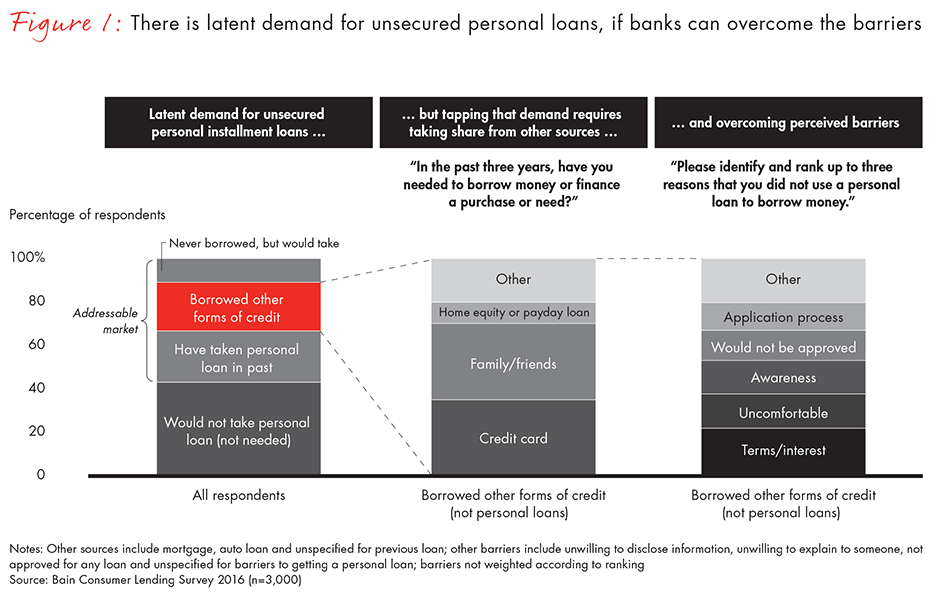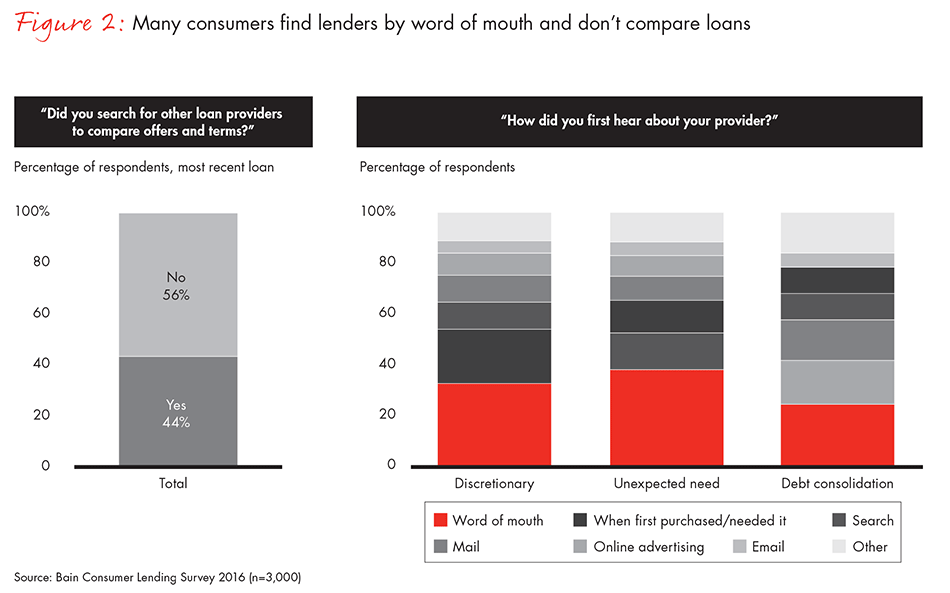Brief
 }
}
The US personal lending market has been jolted by a raft of new competitors. Fintech startups, large technology firms, even venerable investment banks such as Goldman Sachs have made incursions, and competition will only intensify over the next few years. To capture their fair share of the profit pool in this $1.54 trillion market, traditional banks will have to redefine their business models through a tailored approach that is based on a much more nuanced understanding of the financial and experience needs of their target customers.
There is significant economic opportunity on the line for lenders, especially for banks with major credit card businesses, which have seen their fee revenues under pressure and their costs rise for rewards programs, increasing their reliance on revolving balances. For one thing, the US personal lending market is large, fragmented and surprisingly underserved. The leading five banks account for only about 35% of the market (excluding credit cards and home equity lines of credit), with a long tail of medium and small commercial banks, credit unions and alternative financing providers serving this sector.
Significant latent demand exists in personal, unsecured installment loans, despite the many potential solutions available to borrowers and prospects, a new Bain & Company survey of 3,000 US consumers found (see Figure 1). Moreover, personal lending offers an attractive and sustainable source of revenue, compared with declining interchange fees for credit cards.
Direct lenders powered by technology that improves a specific aspect of the lending activity chain—origination, underwriting, fulfillment or servicing—pose the greatest threat to incumbent banks. Leading technology firms such as Apple and Amazon have brands that resonate with consumers, and they can seamlessly integrate lending with their established product and service models. Apple now offers phone leasing, and Amazon moved into student lending in partnership with Wells Fargo, though political opposition forced them to end the venture. Other digital service platforms could serve as launch pads for lending products, including the payment wallets of Google and Samsung, and the new Facebook M virtual assistant.

Banks still have inherent strengths they can build on, in order to retain and gain share in this profitable sector. In distribution, traditional branch-based lending still matters in loan origination, though digital channels will become dominant within the next five years, we believe. Direct alternative lenders must rely on their investors’ confidence to be able to fund sustained loan growth, whereas banks can leverage low-cost deposits to manage through economic cycles. Banks also possess a wealth of data on their customers, from longitudinal data on money movement to data on cross-channel servicing behavior, which can be used to predict consumer acceptance of products, ability and willingness to pay, and early warning of potential default for portfolio management. That gives banks a platform for innovation that enables them to differentiate themselves from niche entrants.
Even with these potential advantages, it is almost impossible for a bank to excel in every personal lending category with all types of consumers in their diverse needs.
To succeed, banks will have to make explicit decisions on where to play—that is, which customer segments, product types and risk characteristics to emphasize and which to cede. In parallel, they will have to make choices on how to win—which lending capabilities they will excel in, and which can be at parity with the rest of the industry.
Joe Fielding, a partner with Bain's Financial Services practice, shares three steps that banks can take to compete with a raft of new competitors and retain and gain share in this profitable sector.
Consumers’ attitudes and perceptions about lending are critical to inform lending strategies, and Bain’s new survey offers insights in this regard. The survey found:
- Customer advocacy matters. One-third of respondents found their current provider through word of mouth (see Figure 2). This underscores the importance of creating an experience that will delight customers and lead them to recommend the bank to friends and family.
- Distribution and marketing matter in loan origination. Of respondents who take a loan, more than half do not compare offers across different lenders; they just take the first one they encounter. Being at the right place at the right time plays a big role in acquiring new business.
- Many prospective borrowers are not well served by current lending alternatives. Some 22% of customers who qualify for a personal loan choose to borrow in ways that make less financial sense, such as taking a payday loan, revolving a balance on credit cards, or borrowing from family or friends. This behavior often stems from barriers including lack of awareness, lack of trust or difficulty with the application process—not just from creditworthiness or price.
- Banks have to excel on several specific attributes, not just on price. The reasons for choosing a lender, or for deciding not to borrow from an institution, depend on the purpose of the loan, the customer’s demographics and even the distribution channel chosen. For example, respondents with strong credit scores care more about loan terms, while respondents with poor to fair credit scores care much more about high odds of approval and a fast, easy application process (see Figure 3). For respondents using branches, customer service and low interest rates have greater weight; those applying through digital channels cite an easy process as a key factor in their application decision.


The survey analysis and our experience working with leading banks suggests that an effective personal lending model rests on four pillars.
-
Tailor the lending experience to the customer’s needs. One way that niche lenders have shaken up the personal lending market is through innovative distribution and origination. For example, for people who are interested in purchasing artwork at the lower end of the market, spending $10,000 or even $1,000 all at once can feel financially irresponsible. Online lender Art Money seeks to change the mental math. Using Art Money, customers pay a minimum 10% deposit, take the artwork home and pay the remaining balance over 9 months, interest-free. The clean, attractive Art Money website has an easy application process, which runs a credit check in about 15 seconds, and it links to participating galleries. The average amount of more than 500 loans granted since Art Money’s launch in April 2015 has been around $5,000, and Art Money reported there have been no defaults through October 2016.
At many banks, by contrast, lending officers ask consumers about the intended use of the funds for the purpose of underwriting, but regardless of the reason given, the overall process and experience comes in one flavor. Yet because the emotional and rational criteria for choosing a lender vary so widely by loan purpose and demographics, it’s critical to recognize how each event that triggers borrowing— buying artwork, debt consolidation, emergency dental surgery, a wedding—merits a tailored approach by the bank. There is ample room for banks to innovate in distribution and origination, particularly for affluent mass-market customers who are not desperate for cash, want an easy process and seek what they perceive as a good deal.
-
Build a modular, repeatable model across multiple lending experiences. Banks should make it easy for the consumer to apply and get fast approval, with a minimum of data input needed by him or her, and on a fully digital/mobile interface integrated with the payment/disbursement platform. Customers often want the flexibility of multiple payment options.
The process should give the customer a feeling of being in control, for example, by signaling that he or she will be approved. And it should address anxieties around borrowing through clear, simple language about, say, the dollar cost of interest per month rather than the more abstract concept of annual percentage rate.
Models are repeatable when they have modular components that can be scaled up, including origination and underwriting workflows, risk and pricing analytic engines, fulfillment and servicing operations, and capabilities in designing and managing a great customer experience.
- Develop large-scale marketing and distribution capabilities. Lenders must be able to reach customers to raise awareness through marketing, at the point of sale, and through both digital and physical distribution. Banks may need intermediaries or partners to get close to the moment of need. For example, wedding planners or retailers could receive funds directly and offer loans as part of the overall service to consumers.
-
Make the model durable through the cycle. The lending model should be resilient to ups and downs through the business and credit cycle, along the three dimensions of funding, compliance and underwriting. To ensure that funding is stable, banks should leverage access to low-cost funding, including securitization, which requires modular, standardized approaches to product design in origination and servicing. For compliance and regulatory oversight, using automated engines to codify and apply rules will provide both consistency and clarity. Finally, underwriting that takes advantage of available behavioral and application data can provide superior risk-based decisions, outcomes and returns.
US consumers have more choices than ever for personal loans, notably through tech-savvy companies with strong brands and massive reach. Banks that assume their current lending operations will roll along at acceptable growth rates risk a rude surprise as customers shift to alternatives that are easier to negotiate and faster to approve applications. Those banks that take a more tailored approach to become highly relevant to consumers’ particular needs at the right moment stand a far better chance of presenting a strong proposition that both delights consumers and improves the bank’s economics.
Joe Fielding is a partner and Martin Magnone is a principal in Bain & Company’s Financial Services practice. They are based in New York.


